2023 MnSHIP Table of Contents
Chapter 1
Plan Overview
The Minnesota Department of Transportation is responsible for constructing, operating and maintaining almost 12,000 mile state highway system. This system plays a key role in supporting the state’s economy and quality of life. Businesses rely on the system to move their goods and raw materials throughout the state. In addition, state highways connect Minnesotans to other transportation networks and to state, national and global markets.
MnSHIP Purpose
Through the 20-Year Minnesota State Highway Investment Plan (MnSHIP), the Minnesota Department of Transportation decides and communicates capital investment priorities for the state highway system for the next 20 years. MnSHIP is required by Minnesota statute. It must identify investment priorities given current and expected funding and be updated every five years. This MnSHIP update spans the 20-year planning period from 2023 to 2042 and replaces the 2018-2037 MnSHIP.
MnDOT considers many factors in developing MnSHIP. The plan prioritizes future investments to address the widening gap between highway revenues and construction costs. MnSHIP also considers federal and state laws, MnDOT policy and current and expected future conditions on the state highway system. These factors are described in more detail in Chapter 2: Existing Conditions and Trends.
MnSHIP describes how MnDOT will use capital investments to repair, replace and improve the state highway system. The plan does not address how MnDOT funds the operation of the system or day-to-day maintenance. MnDOT’s Transportation Asset Management Plan describes how the department maintains highway infrastructure and operates the highway system.
Relationship to MnDOT’s Plans and Programs
MnSHIP is part of a “family of plans” that connects statewide vision and policy direction for transportation in Minnesota to how MnDOT selects projects and makes improvements on the transportation system. The “family of plans” is shown in Figure 1-1. Together, the plans serve as a framework for implementing a multimodal transportation system throughout Minnesota.
Figure 1-1: Family of Plans
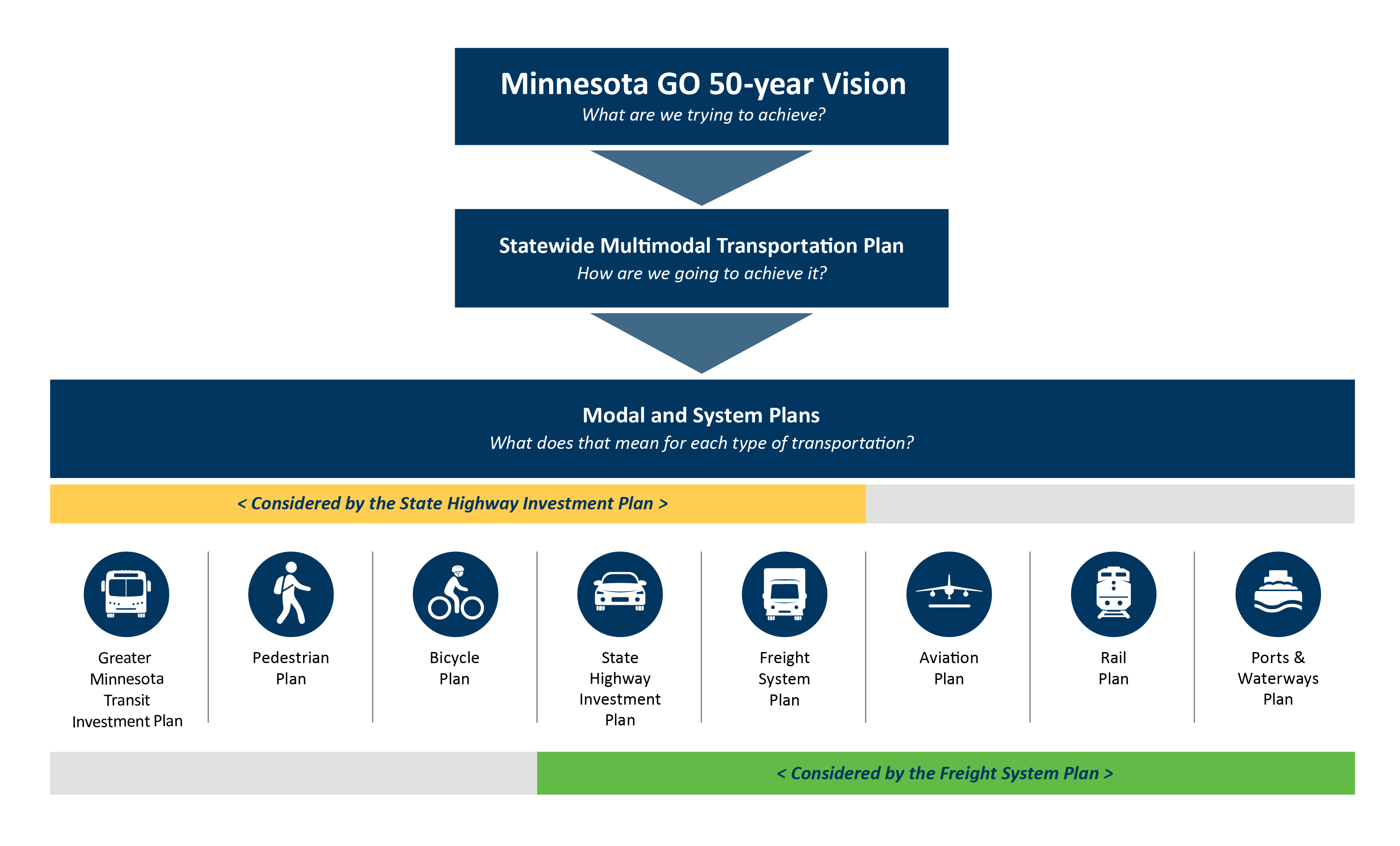
Figure 1-2: Minnesota GO Vision
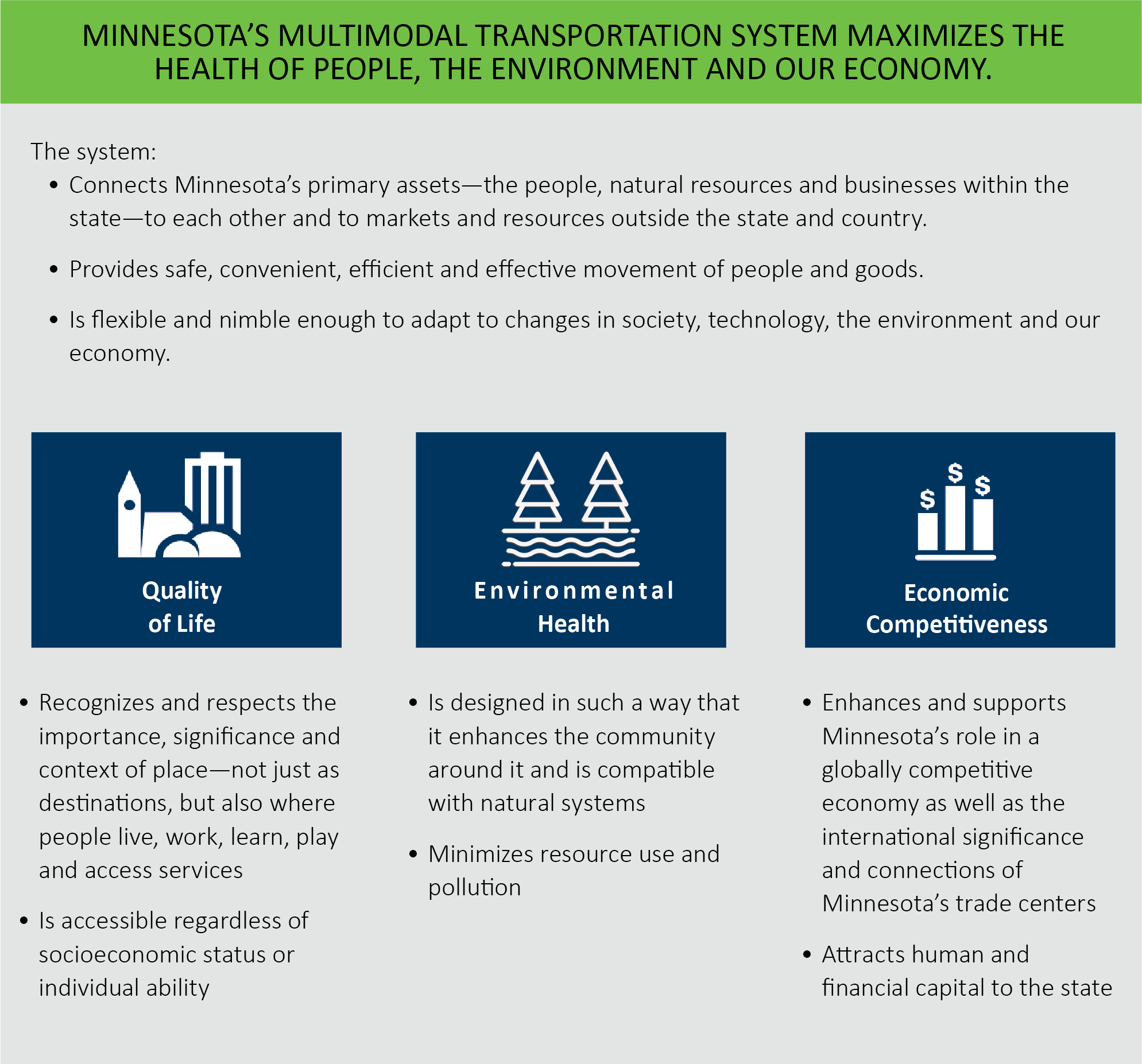
The Statewide Multimodal Transportation Plan was adopted in 2022. It identified objectives, performance measures and strategies in six policy areas to make progress toward the Minnesota GO Vision and 16 legislative goals for transportation. The SMTP covers all the ways people and goods move around Minnesota and is for everyone with a role in implementing transportation. The objectives are listed in no particular order in Figure 1-3, and all are critical focus areas for the upcoming years.
Figure 1-3: Statewide Multimodal Transportation Plan Objectives
| Statewide Multimodal Transportation Plan Objectives |
|---|
| Transportation Safety. Safeguard transportation users as well as the communities the systems travel through. Apply proven strategies to reduce fatalities and serious injuries for all modes. Foster a culture of transportation safety in Minnesota. |
| System Stewardship. Strategically build, manage, maintain, operate and adapt the transportation system based on data, performance and community needs. Ensure effective and efficient use of resources. |
| Climate Action. Advance a sustainable and resilient transportation system. Enhance transportation options and technology to reduce greenhouse gas emissions. Adapt Minnesota’s transportation system to a changing climate. |
| Critical Connections. Maintain and improve multimodal transportation connections essential for Minnesotans’ prosperity and quality of life. Strategically consider new connections that help meet performance targets and maximize social, economic and environmental benefits. |
| Healthy Equitable Communities. Foster healthy and vibrant places that reduce disparities and promote healthy outcomes for people, the environment and our economy. |
| Open Decision Making. Make equitable transportation decisions through inclusive and collaborative processes that are supported by data and analysis. |
MnDOT uses the STMP objectives and strategies to inform modal and system investment plans. These plans include MnSHIP as well as the State Aviation System Plan, the Statewide Bicycle System Plan, the Statewide Freight Plan, the Statewide Ports & Waterways Plan, the State Rail Plan, the Greater Minnesota Transit Investment Plan, the Statewide Pedestrian Plan and a collection of supporting plans. These modal and system plans are updated every four to six years. Some help to set specific investment direction, others focus more on general policy guidance and some do both.
MnSHIP is a system investment plan that sets direction specifically for the state highway system. MnDOT has used performance-based planning to develop MnSHIP for more than 15 years. As a performance-based plan, MnSHIP uses measures and targets to assess system performance, identify needs and develop investment priorities MnSHIP links policies and objectives in the Minnesota GO 50-Year Vision and the SMTP with capital investments on the state highway system.
Organization of Chapters
The chapters in this plan are based on the steps in the plan’s development process, presented together in Figure 1-4. The first step in the MnSHIP planning process involves gathering information from various sources. This chapter covers federal and state legislative requirements, MnDOT policy and describes the MnSHIP investment categories. Chapter 2: Existing Conditions and Trends covers current system conditions and trends.
The second step in the MnSHIP process involves projecting revenue for state highways. Chapter 3: Revenue Outlook describes the revenue scenarios developed for the plan. The third step in the plan process involves identifying needs. Chapter 4: Investment Needs describes the amount of money needed to meet performance targets and key objectives for each investment category.
The fourth step in the MnSHIP process involves developing investment scenarios and conducting public outreach on investment preferences. The details of this process are described in Chapter 5: Development of Investment Direction.
The fifth step in the MnSHIP planning process is setting the investment direction. Once the results from public outreach were analyzed, MnDOT gathered input from internal staff and developed an investment direction for MnSHIP. This direction describes how MnDOT is going to invest in the state highway system for the next 20 years. The details of this investment direction are presented in Chapter 6: Investment Direction. Needs not addressed by the MnSHIP Investment Direction are discussed in Chapter 7: Unmet Needs.
Figure 1-4: MnSHIP Chapters and Development Process
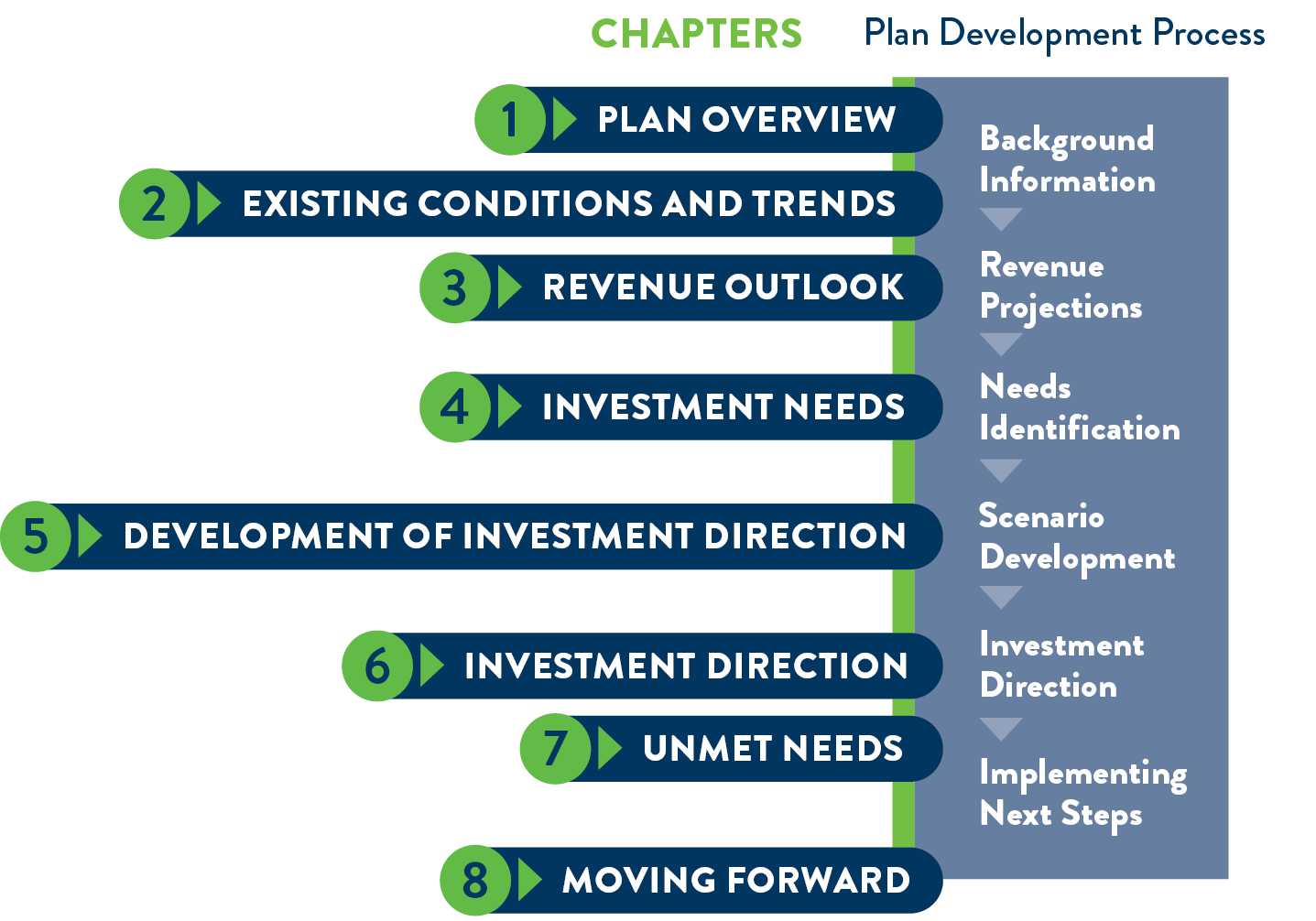
Once MnSHIP is complete, MnDOT districts select projects that follow the investment direction and strategies established in the plan. These planned and programmed projects are presented in the 10-Year Capital Highway Investment Plan (CHIP).
Federal Law
A new federal surface transportation bill, the Infrastructure Investment and Jobs Act (IIJA), was signed into law on November 15, 2021. It authorized approximately $550 billion in federal funding for fiscal years 2022 through 2026 for infrastructure projects, including $350 billion for highway projects, an increase from the previous federal bill. IIJA continues many of the requirements first established in Moving Ahead for Progress in the 21st Century (MAP-21), including the use of performance measures and emphasizing investment on the National Highway System. The new federal bill has an increased emphasis on climate resilience and equity.
The requirements in IIJA affect MnDOT, as well as MnDOT’s transportation partners, in several ways. Appendix E: Planning Requirements details the role the SMTP and MnSHIP have in addressing the requirements in IIJA.
Impact Of IIJA On MnSHIP
- Requires states to make progress toward nine national goals for the National Highway System (NHS). The national goal areas are (1) safety, (2) infrastructure condition, (3) congestion reduction, (4) system reliability, (5) freight movement and economic vitality, (6) environmental sustainability, (7) reduced project delivery delays, (8) improved resiliency and reliability of the transportation system and reduction or mitigation of storm water impacts of surface transportation and (9) enhancement of travel and tourism.
- Continues performance requirements on the NHS. States are required to report on pavement condition, bridge condition, safety and reliability performance. USDOT has set minimum performance thresholds for Interstate pavement condition and NHS bridge condition. MnDOT sets targets for the other federal performance areas in coordination with the Metropolitan Planning Organizations.
- Creates multiple new discretionary grant programs and increases existing discretionary grant program funding. IIJA authorized over $35 billion in competitive roadway grants between 2022 and 2026.
- Increases funding for climate resilience and electric vehicle infrastructure. IIJA includes a new $5 billion electric vehicle charging infrastructure formula program to strategically deploy charging infrastructure and a $7 billion PROTECT program to make transportation infrastructure more resilient to future weather events.
State Requirements
State policy and legislative requirements had a strong influence on the development of MnSHIP. Minnesota statute 174.01 identifies 16 goals of the state transportation system. These goals guided the development of MnDOT’s Family of Plans.
State legislative requirements for MnSHIP are contained in Minnesota statue 174.03. The law requires MnDOT to create a fiscally constrained, performance-based 20-year capital investment plan for the state highway system every five years. As part of the plan, MnDOT must analyze and track the effect of recent investments, identify needs, establish priorities for projected revenue and identify strategies to ensure the efficient use of resources. In 2021, the law was updated to include a requirement that MnDOT establish investment priorities that provide for cost-effective preservation, maintenance and repair of the state highway system. State legislative requirements specific to MnSHIP, and the MnSHIP chapter in which they are addressed, are presented in Figure 1-5.
MnDOT is also responsible for carrying out programs initiated by the Minnesota State Legislature for projects on the state highway system, such as Corridors of Commerce.
Figure 1-5: Chapters in MnSHIP Addressing Legislative Requirements for MnSHIP
| Minnesota Statutes for MnSHIP (Section 174.03, Subd. 1c) | Location in MnSHIP |
| Incorporates performance measures and targets for assessing progress and achievement of the state’s transportation goals, objectives and policies identified [in this statute] for the state trunk highway system and those goals, objectives and policies established in the Statewide Multimodal Transportation Plan. Performance targets must be based on objectively verifiable measures, and address, at a minimum, preservation and maintenance of the structural condition of state highway bridges and pavements, safety and mobility |
|
| Summarizes trends and impacts for each performance target over the past five years. |
|
| Summarizes the amount and analyzes the impact of the department’s capital investments and priorities over the past five years on each performance target, including a comparison of prior plan projected costs with actual costs. |
|
| Identifies the investments required to meet the established performance targets over the next 20-year period. |
|
| Projects available state and federal funding over the 20-year period, including any unique, competitive, time-limited, or focused funding opportunities. |
|
| Identifies strategies to ensure the most efficient use of existing transportation infrastructure, and to maximize the performance benefits of projected available funding. |
|
Establishes investment priorities for projected funding which must:
|
|
| Identifies those performance targets identified under clause (1) not expected to meet the target outcome over the 20-year period together with alternative strategies that could be implemented to meet targets. |
|
MnDOT Policy
MnDOT policies take many forms and those considerations that apply to MnSHIP have been applied throughout the plan development process. In addition to the Minnesota GO Vision and Family of Plans, the Transportation Equity Statement of Commitment and Complete Streets Policy are MnDOT policy requirements that apply to MnSHIP.
Transportation Equity Statement of Commitment
As part of the 2022 SMTP, MnDOT adopted a statement of commitment to advance its work on transportation equity.
Acknowledgement of Past Harms
MnDOT acknowledges the transportation system and agency decisions have underserved, excluded, harmed and overburdened some communities. We understand some of our past decisions denied Black and Indigenous communities as well as people with disabilities the full participation of transportation benefits. These and other underserved communities have historically carried disproportionate burdens of transportation decisions.
What Transportation Equity Means to MnDOT
MnDOT is committed to creating an equitable transportation system.
Transportation equity means the benefits and burdens of transportation systems, services and spending are fair and just, which historically has not been the case. Transportation equity requires ensuring underserved communities, especially Black, Indigenous and People of Color, share in the power of decision making.
The journey of transforming our transportation systems, services and decision-making processes will require ongoing listening, learning, changing, implementing and adapting.
Everyone in our agency regardless of position or work assignment has a role to advance transportation equity. We will partner with community members, community-based organizations, transportation service providers, Tribal Nations and government institutions to evolve our work and to change outcomes for our communities.
Complete Streets Policy
MnDOT policy requires a complete streets approach in all phases of project delivery. On all projects, MnDOT evaluates and balances the needs of all users (pedestrians, bicyclists, freight, transit, motor vehicles, etc.) during planning, scoping, design, construction, operations and maintenance of the state highway network. Project development analysis includes the access and mobility needs of user groups moving both along state highways and crossing state highways. The objective is not all modes on all roads, but rather, interconnected and integrated networks for all users. Districts must evaluate opportunities to address the needs of all users both at the individual project level and when developing Area Transportation Improvement Programs and 10-Year Capital Highway Investment Plans.
Minnesota’s State Highway System
The state highway system is a multimodal network serving many different transportation users. These users include motorists, freight carriers, transit passengers, bicyclists and pedestrians. It also connects these users to other transportation systems, such as transit networks, rail, aviation and waterways, as well as county and city roads.
The importance of the state highway system is demonstrated by its use. At almost 12,000 miles, the system comprises only 8% of Minnesota’s total road miles yet carries almost 60% of the vehicle miles traveled and moves the majority of freight. State highways are central to many communities in Minnesota and their conditions directly affect residents’ quality of life.
A strong economy depends upon a well-maintained and well-connected transportation network. Minnesota businesses rely on the state highway system’s size, connections and pavement and bridge conditions to carry freight throughout the state. To keep Minnesota economically strong into the future, MnDOT needs to maintain and improve the state highway system. The size and the age of Minnesota’s transportation system demonstrate the scope of the state highway system’s investment need:
- 50% of state highway pavements are more than 50 years old
- 47% of MnDOT owned highway bridges are more than 40 years old
Which Roads Make Up the State Highway System?
The state highway system includes all Interstate highways, U.S. highways and Minnesota state highways. These roads fall into two categories: National Highway System roadways and non-NHS roadways. NHS roadways serve statewide and interstate travel and are the primary connections between large urban areas throughout the state and beyond. Non-NHS state highways provide important connections for regional and local travel and generally carry lower traffic volumes. Figure 1-6 shows the extent of the state highway system.
Figure 1-6: Minnesota's State Highway Network
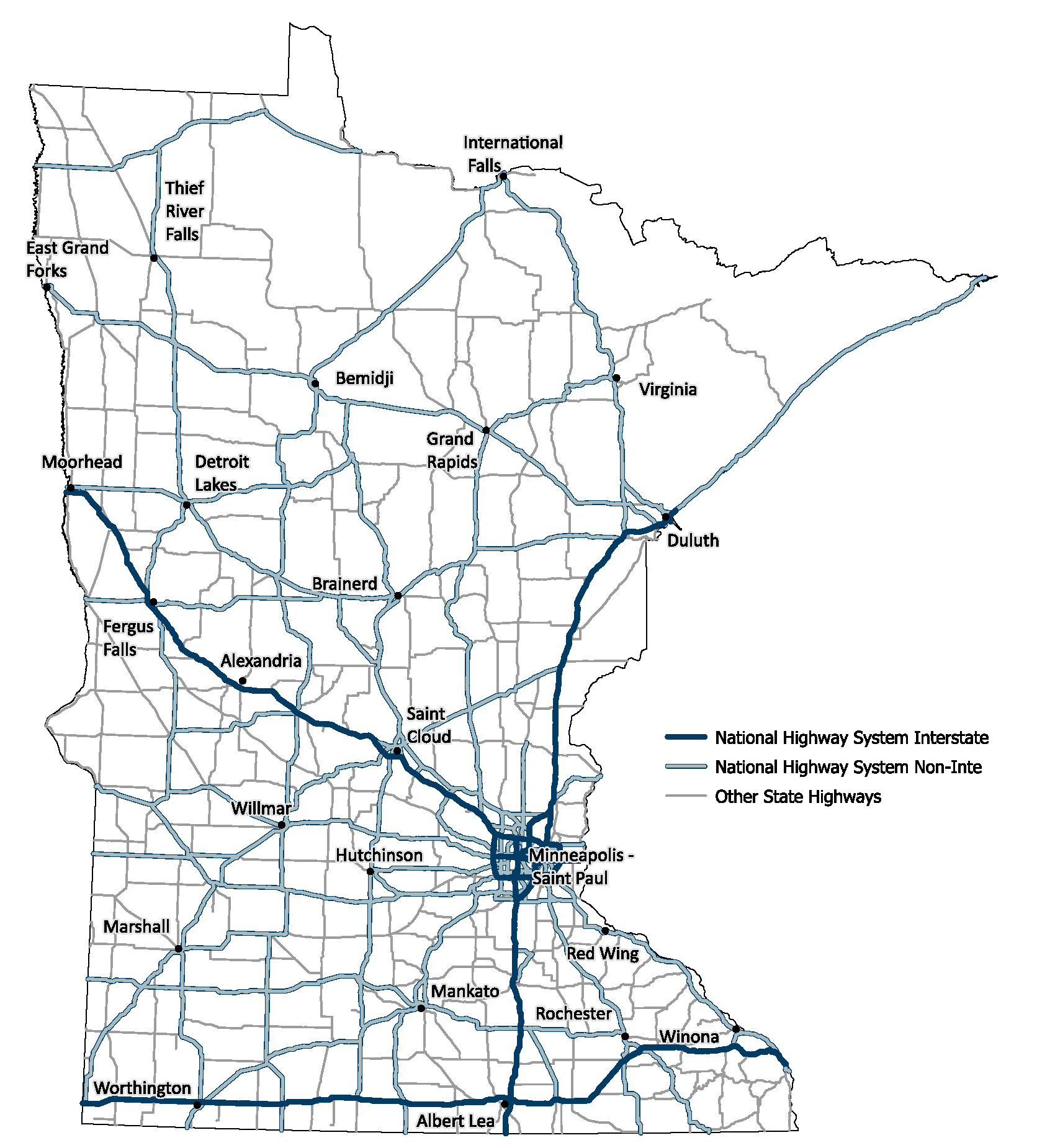
MnDOT’s Organization and Management of the State Highway System
State highway construction and maintenance responsibilities are divided into eight MnDOT districts. Figure 1-7 maps the district boundaries. MnDOT’s Central Office headquarters are located in St. Paul, near the state Capitol building.
Figure 1-7: MnDOT District Boundaries and Headquarters
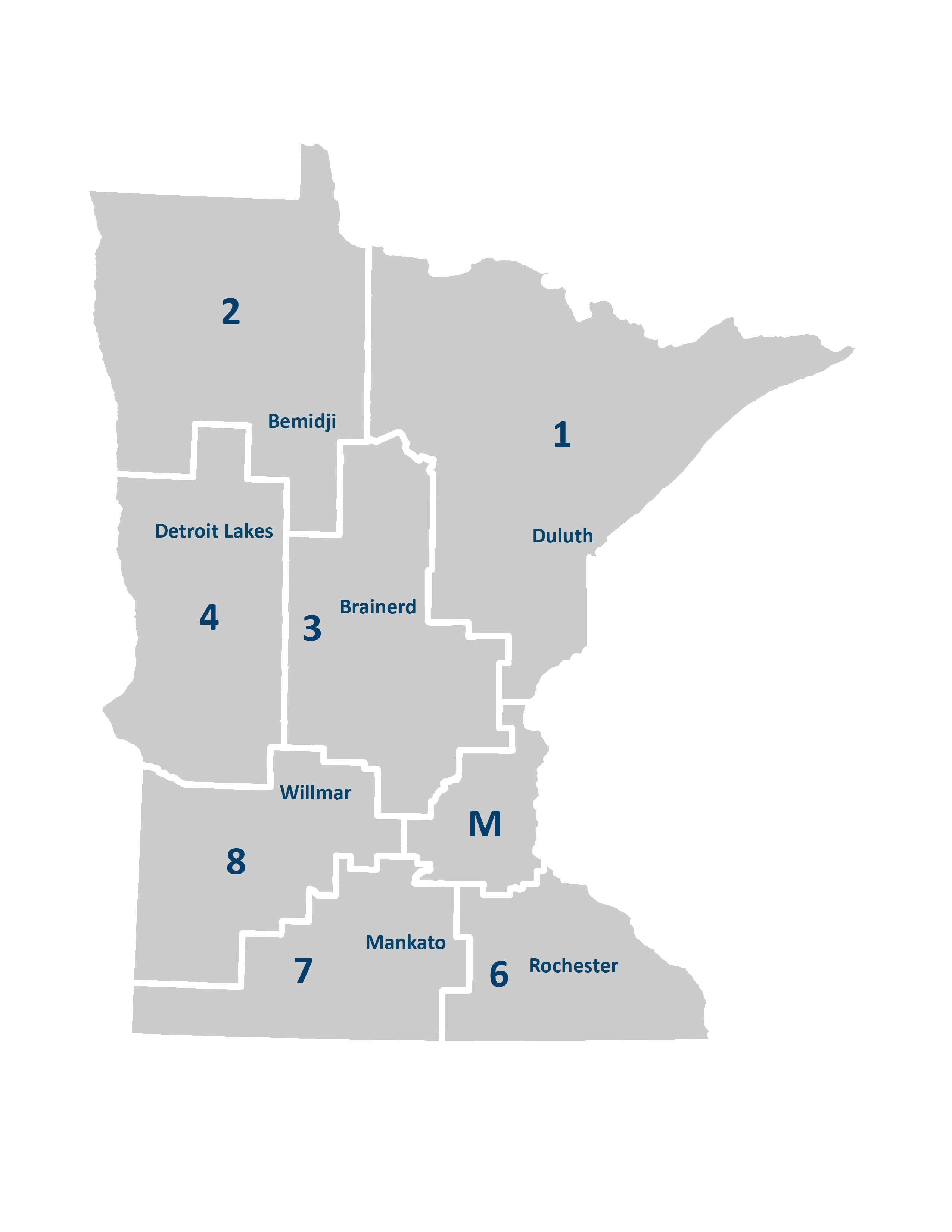
Investment Category Descriptions
MnDOT invests in the state highway system through various types of capital improvement projects. Some projects enhance the condition of existing infrastructure, whereas others add new infrastructure to the system. Investment categories are components of projects. A single MnDOT project can include investment from multiple different investment categories. There are many competing priorities for investment along the state highway system. MnDOT is responsible for selecting investments that best balance these priorities. This is especially challenging given the gap between MnDOT’s projected transportation revenues and investment needs.
MnDOT tracks capital investment in highways by investment categories. The 2017 version of MnSHIP identified 14 investment categories. This MnSHIP update substantially revised the investment categories to address new focus areas and simplify reporting. New investment categories include Climate Resilience, Advancing technology and Main Streets/Urban Pavements. The individual categories are separated into five major investment objective areas as illustrated in Figure 1-8.
Figure 1-8: MnSHIP Investment Categories
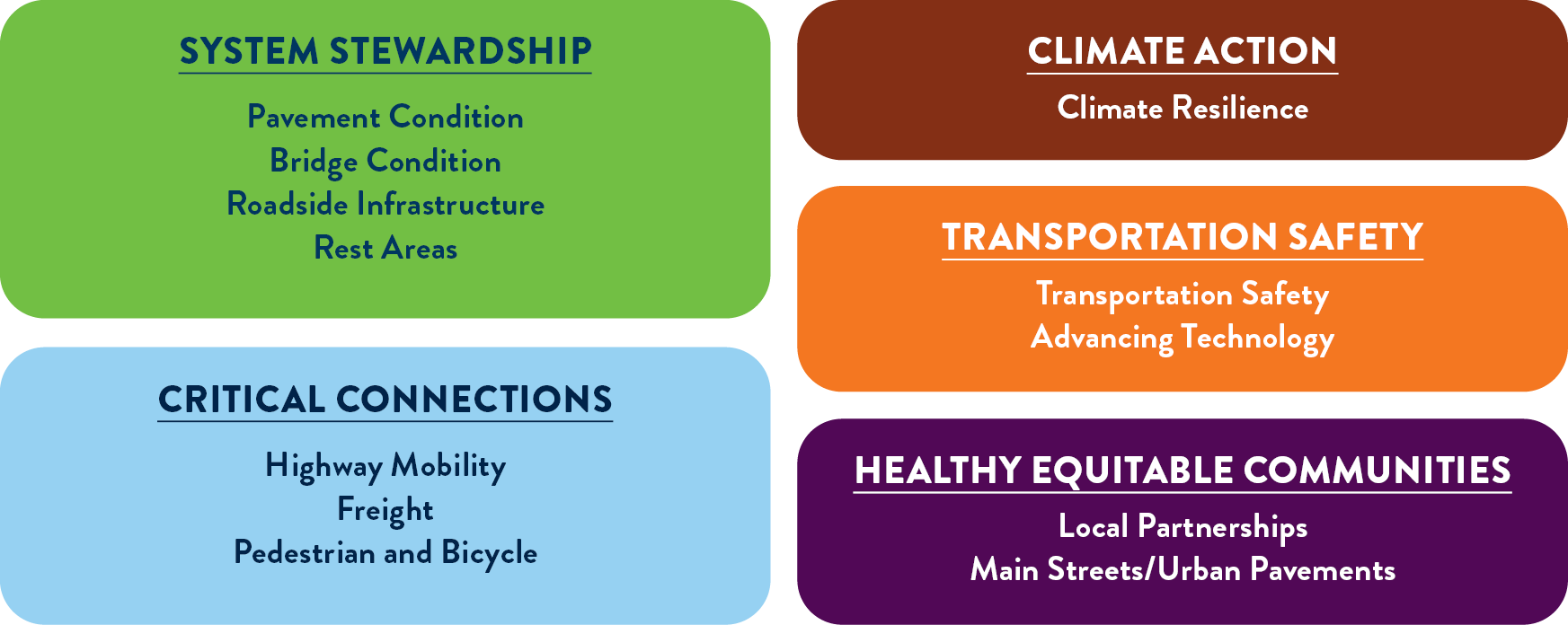
System Stewardship: Category Descriptions
System Stewardship includes five investment categories: Pavement Condition, Bridge Condition, Roadside Infrastructure and Rest Areas.
Pavement Condition
MnDOT preserves the structural integrity and smoothness of its pavements through investment in the Pavement Condition category. MnDOT seeks to maintain pavements in good condition and minimize the share in poor condition. This category includes the repair or replacement of existing pavement on the state highway system. Typical improvements to pavements include:
- Overlays – Putting new pavement on top of old pavement to smooth the road surface
- Mill and overlays – Removing a few inches of the existing pavement and then putting new pavement on top
- Reconstruction projects – Completely rebuilding the road and the road base
- Preventive maintenance – Activities to help slow pavements from deteriorating from good to fair condition
Pavements are a critical part of MnDOT’s transportation network, providing mobility and access to a wide range of users. MnDOT maintains over 11,703 miles of state highways that serve vehicles, freight, transit, bicycle users and pedestrians. Smooth pavements are critical for the safe and efficient movement of goods in Minnesota. On an average day, there are more than 90 million vehicle miles traveled on Minnesota state highways.
The majority of Minnesota’s highways were originally constructed between 60 and 70 years ago. Pavements generally need to be fully reconstructed every 50 years. MnDOT also needs to make repairs at regular intervals to prolong pavement life and reduce total life-cycle costs. MnDOT is better able to fulfill its responsibilities as stewards of the highway system by making the proper fix at the proper time.
Bridge Condition
The Bridge Condition category includes the repair or replacement of existing bridges on the state highway system. Construction of new bridges on the state system is also included in this category. Typical bridge improvements include replacement, repair and preservation activities such as painting. The Bridge Condition category does not include surrounding or supporting elements for bridges, such as signs, pavement markings or lighting.
More than 2,800 of Minnesota’s 7,500 bridges are on the state highway system and are maintained by MnDOT. Most bridges last 60 to 80 years before needing replacement with adequate maintenance and repair projects. Delaying repairs can lead to more extensive maintenance needs and shorter service life. MnDOT uses asset management principles to plan optimal preventive maintenance, preservation, rehabilitation and replacement projects. By planning bridge investments in a timely and cost-effective manner, MnDOT is able to maintain these vital connections. A robust network of bridges is vital for the safe and efficient movement of goods in Minnesota.
Roadside Infrastructure
Roadside Infrastructure includes an array of supporting infrastructure found on the state highway system. This infrastructure enhances the safe, reliable and efficient movement of people and goods throughout the state. Investments in this category include the repair or replacement of existing roadside infrastructure elements including:
- Culverts, deep stormwater tunnels, storm sewer systems, stormwater management and other drainage structures that carry water away from or under the road
- Traffic signals, lighting and Intelligent Transportation Systems that enhance safety and provide information
- Highways signs and sign structures including traffic and directional signs
- Guardrails and concrete barriers, including cable-median barriers that protect people and infrastructure
- Noise walls
- Pavement markings
Roadside infrastructure improvements are often completed with a pavement or bridge project. MnDOT also conducts stand-alone projects, such as culvert replacement projects along segments of road with poor drainage or culverts.
Rest Areas
The Rest Areas investment category is a new category in this MnSHIP update. It includes the repair and maintenance of existing state highway rest area buildings, sites and parking lots including investments to make them compliant with the Americans with Disabilities Act.
Rest areas serve as a countermeasure to drowsy driving, reduce unsafe highway shoulder stops, support freight movements and promote state and regional tourism as well as provide convenient services for travelers. By providing adequate and properly spaced rest areas along the state highway network, MnDOT can meet the demand and expectations of the traveling public.
Climate Action: Category Descriptions
Climate Action is a new objective area established in the SMTP. Investments in this area aim to advance a sustainable and resilient transportation system that adapts to a changing climate.
Climate Resilience
The Climate Resilience investment category improves state highway infrastructure to withstand increasingly extreme weather events. Types of investments include flood mitigation to address locations with recurring flooding issues, living and structural snow fences to reduce snowdrifts and proactive resilience enhancements to limit weather impacts on the state highway system before they occur.
Investment in this category also adapts the state’s transportation system to put less stress on the environment by reestablishing native habitats and mitigating impacts from the transportation system. The investment category includes planting more native and climate-adaptive vegetation along roadsides. This helps with stormwater management by increasing infiltration and slope stabilization, provides more shade and also increases the appeal and comfort of people walking and bicycling.
Transportation Safety: Category Description
There are two investment categories under the transportation safety objective area: Transportation Safety and Advancing Technology. Safety elements are included in all MnDOT projects. Safety benefits are the primary focus for investment in these categories.
Transportation Safety
The Transportation Safety category includes investments in new highway safety improvements. Typical improvements include lower-cost, high-benefit engineering solutions, such as rumble stripes, lighting, signage and new cable median barriers. MnDOT also invests in higher-cost treatments, such as signals and reduced conflict intersections (e.g., roundabouts, median refuges and J-turns). These higher-cost improvements are used to address locations with a sustained history of crashes.
Vehicle crashes are the leading cause of death for people under the age of 35 and the second leading cause of accidental death in the nation. Crash-related deaths and serious injuries create significant costs for individuals, families and society. On average, more than one person died every day in 2022 on Minnesota roads (444 total) and more than four were seriously injured. MnDOT and its partners have made reducing fatalities and serious injuries a top priority through:
- The Toward Zero Deaths initiative. MnDOT and its partners use a data-driven, multi-disciplinary “four Es” approach – education, engineering, enforcement and emergency services – to target and reduce fatalities and serious injuries. By implementing the TZD[1] approach, the state of Minnesota has seen a dramatic decline in traffic fatalities during the past decade.
- Incorporate safety improvements into regular construction projects through planning, design and engineering. MnDOT includes safety elements as part of its highway construction projects.
- Proactive lower-cost, high-benefit safety features. Lower-cost safety improvements may be newly installed as part of a pavement project, including edge treatments (rumble stripes and rumble strips), guardrail and pavement markings, or as stand-alone projects. MnDOT has also developed District Safety Plans for each of its eight districts. The plans prioritize strategies at high-risk locations and identify appropriate treatments that are proven to reduce fatal and serious injury crashes.
- Improvements at sustained crash locations. These are locations with a consistently high-crash rate over a five-year period compared to similar locations across the state. Improvements at these locations tend to be higher-cost intersection improvements and can be targeted for motorized and non-motorized modes. Projects in this category include improvements such as roundabouts and passing lanes.
Advancing Technology
Advancing technology investments are focused on improving MnDOT’s Intelligent Transportation System (ITS) infrastructure and Transportation System Management Operations (TSMO). These investments will help the safe and efficient movement of people and goods and prepare the state highway system for the widespread use of connected and autonomous vehicles. Investments in this category include expanding fiber infrastructure, adding ITS assets and piloting infrastructure for connected and autonomous vehicles.
The Advancing Technology investment category was created to react directly to emerging trends occurring in the transportation and employment sectors which have the potential to change commuting and working patterns substantially. These trends include the adoption of connected and autonomous vehicles and new transportation technologies. These trends require enhanced fiber networks, especially in rural areas. Without investment in this category, Minnesota runs the risk of falling behind other parts of the country and becoming less economically competitive.
Critical Connections: Category Descriptions
There are three categories in which MnDOT invests to improve transportation connections: Highway Mobility, Pedestrian and Bicycle and Freight. These investment categories comprise the Critical Connections investment area.
Highway Mobility
The Highway Mobility investment category focuses on improving the vehicular movement of people and freight on the National Highway System, the priority network for MnSHIP. Minnesota is projected to add over 600,000 residents statewide between 2020 and 2050 according to the State Demographer, with much of this growth taking place in the Twin Cities region. Maintaining reliable and safe connections between and within the state’s regions and urban centers while accommodating this growth remains an important objective of highway mobility. Through investments in Highway Mobility, MnDOT aims to increase mobility throughout the state, increase job accessibility, improve trip reliability and enhance travel options.
In the Twin Cities metro area, mobility projects include managing delay by providing cleaner, convenient and reliable alternatives in congested corridors. Population growth pressures in the region are accompanied by competing demands for continued reductions in emissions to ensure acceptable levels of air quality, while also maintaining the benefits of high levels of access to opportunities that make it attractive to residents and businesses. Highway mobility investments can promote these objectives through network improvements that smooth traffic flow and also enhance transit service access. The investment strategies for Highway Mobility in in the Twin Cities region align with the investment direction established in the Metropolitan Council’s 2040 Transportation Policy Plan. These investments follow a tiered approach and include:
- Active Traffic Management, Travel Demand Management and transit-supportive investments. Operational improvements to help manage traffic flow, which include variable message signs, freeway ramp metering, dynamic signing and re-routing, dynamic shoulder lanes, reversible lanes and lane-specific signaling. Investments to increase traveler options.
- Spot mobility improvements. Lower-cost, high-benefit projects that improve traffic flow and provide bottleneck relief at spot locations. These projects include intersection or interchange modifications and auxiliary lanes.
- Managed lanes. Projects that provide a predictable, congestion-free travel option for transit users, those who ride in carpools or those who are willing to pay. Priced managed lanes, known as E-ZPass lanes, currently operate on I-394, I-35W and I-35E. During peak drive times, E-ZPass lanes are free for buses, vehicles with two or more occupants and motorcycles; single-occupant vehicles are charged a fee through an electronic device attached to the windshield.
- Strategic capacity investments. Projects aimed at enhancing mobility, safety, multimodal or freight movements such as improved or new interchanges. General-purpose lanes can be considered in the following instances: to correct lane continuity or where managed lanes have been evaluated and found not feasible.
The strategies listed above also benefit transit in many ways, such as bus-only shoulders, high occupancy vehicle bypass ramps and E-ZPass express lanes. MnDOT also supports TDM initiatives led by local and regional agencies that may not be eligible for state highway investment. The Metropolitan Council recently completed a Regional Travel Demand Management Study that identifies TDM strategies for the Twin Cities region.
In Greater Minnesota, typical investments include spot mobility improvements such as upgraded signals, turn lanes, intersection improvements or passing lanes. Locations for improvements were identified through the Greater Minnesota Mobility Study.
Reducing Vehicle Miles Traveled
MnDOT has adopted a target to reduce per capita vehicle miles traveled (VMT) 14% by 2040. Meeting that goal would reduce the capital investments needed to meet performance targets for Highway Mobility. More investment in this category may jeopardize reaching the VMT target.
Freight
The Freight category includes projects that are eligible for funding as part of the National Highway Freight Program. These include addressing freight bottlenecks, freight safety and mobility improvements, first-last mile connections and intermodal freight improvements. Investments in freight also include preservation and upgrades for truck weigh stations, at-grade rail crossings on the state highway system and truck parking at the state’s rest areas.
Minnesota’s broad range of industries include manufacturing, food production, computer and electronics, fabricated metal, machinery and medical devices. Many of these industries require a safe, reliable and efficient highway system to connect to customers, import raw materials and deliver goods and services. Projections show that the volume of freight is expected to grow 25-45% by 2040, according to the U.S. Department of Transportation.
Weight enforcement conducted at weigh stations ensure that freight being shipped to and through Minnesota is not over weight limits. Enforcement of Minnesota’s truck size and weight laws increases safety and reduces damage to roadways and bridges.
Pedestrian and Bicycle
Pedestrian and bicycle investments provide infrastructure for people to walk, roll and bicycle safely along and across state highways. Examples of MnDOT investments include sidewalks, accessible curb ramps, accessible pedestrian signals at signalized intersections, shared use paths, bicycle lanes and grade-separated facilities.
Bicycle investments aim to improve network connections, quality of life and the environment by providing a safe, comfortable and convenient bicycling network. In addition, the bicycle objectives aim to routinely consider bicycle trips on highways early in the planning process; maintain quality non-motorized infrastructure; facilitate bicycle travel on priority networks and eliminate fatalities and serious injuries statewide.
The Statewide Bicycle System Plan provides guidance for investing in local and regional bicycle connections, a state bikeway network and separated bicycle facilities. The plan recommends that 70% of bicycle investments fund projects to support local and regional networks with the remaining investment in an enhanced State Bikeway Network.
Pedestrian investments include reconstructed and new infrastructure to ensure safe, accessible and convenient pedestrian travel across and along the state highway system. Typical improvements include keeping existing pedestrian infrastructure in compliance with the Americans with Disabilities Act (ADA), building new curb ramps and sidewalks where needed, improving intersections with accessible pedestrian signals and building new pedestrian bridges. MnDOT frequently coordinates pedestrian improvements with other bridge and pavement projects to maximize the impact of MnDOT investments.
Pedestrian infrastructure is important because everyone is a pedestrian – whether your main form of transport is a motor vehicle, bus, train, van, or bicycle and whether you travel using your feet or an assistive device. MnDOT’s pedestrian network consists of more than 600 miles of sidewalk, more than 20,500 curb ramps and more than 100 pedestrian bridges.
The Statewide Pedestrian System Plan guides MnDOT’s pedestrian investments. It helps prioritize and create spaces that are safe and convenient for people to walk along and cross state highways.
Healthy Equitable Communities: Category Description
Investments in this area aim to foster healthy and vibrant places that reduce disparities and promote healthy outcomes.
Local Partnerships
The Local Partnerships category incorporates investment strategies and programs that involve local collaboration and planning. Investments support local priorities on the state highway system where MnDOT partners with local communities to deliver improvements to the state highway system. These include landscaping/beautification projects, improvements supporting economic development, safety and improvements that help to integrate the highway into the local community and improve livability. The category also includes highway ownership realignment agreements where ownership of the roadway is transferred from one roadway authority to another.
Jurisdictional Transfer is a type of investment within the Local Partnerships category. It includes the costs associated with transferring ownership of a road to or from MnDOT. Aligning roads with the correct level of service helps road owners better meet customer expectations for maintenance, ride quality and safety. It’s also easier as stewards of the transportation system if costs associated with constructing, operating, maintaining and replacing roads are better aligned with what is expected for level of service.
The Transportation Economic Development (TED) program is also included in the Local Partnerships category. The TED program gives grants to roadway projects that improve regional economic competitiveness and support new jobs.
Main Streets/Urban Pavements
Main Streets-Urban Pavements is a new category in this update to MnSHIP. Investment in Main Streets-Urban Pavements provides additional funding for projects in cities and towns to deliver more improvements along state highways. This includes segments of the state highway that are non-freeways and function both as a state highway and as a city street in an urban context.
The strategy for investment is to create funding for MnDOT districts to upgrade existing urban pavement projects to longer-term fixes such as reconstructions in order to address other needs. Additional improvements addressed could be local utilities under the road, drainage infrastructure, a longer-term ADA fix, or redesigning the roadway to meet the community’s quality of life and transportation equity needs. These investments allow MnDOT to better partner with local communities on urban pavement projects.
Other: Category Description
Project Delivery
The Project Delivery category includes investments necessary to ensure the timely and efficient delivery of projects constructed on the state highway system. Resources are needed in a number of areas to effectively work with partners on improvements, deliver quality capital projects and optimize MnSHIP investment. These areas include:
- Right of way - to purchase property adjacent to projects for construction and construction staging
- Consultant services - to hire private consultants to supplement MnDOT staff and provide special expertise in preliminary engineering and detailed design work
- Construction incentives - to promote or increase the likelihood of a desired outcome, such as early completion or meeting certain performance outcomes
- Supplemental agreements - to address unanticipated issues that develop during construction, such as unknown contaminated soil
Small Programs
The Small Programs category includes investments that are not specifically identified or prioritized within MnSHIP but make up a part of MnDOT’s overall capital investment. Small Programs typically respond to short-term, unforeseen issues or are used to fund one-time specialized programs that do not fit into a MnSHIP investment category. If funding is required beyond the short-term, an effort is made to incorporate the program into a MnSHIP investment category during the next MnSHIP update. Small Programs in MnSHIP include funds for historic properties, flood and slide repair and cleaning up contaminated materials.
